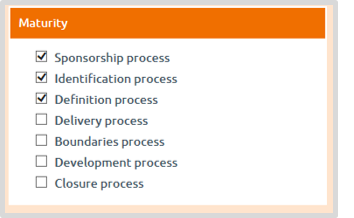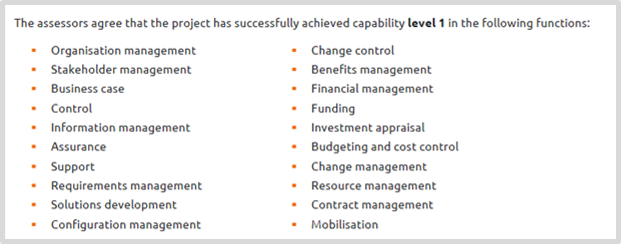We will periodically add sections to this guide so check back from time to time to see what’s new. Follow us on twitter to be notified when new material is available.
It’s not just about measuring maturity:
Much has been written about the effectiveness of checklists in all walks of life. In his book, Atul Guwande* explains how checklists have developed from their role in improving aircraft safety to significantly reducing mortality in surgical procedures.
 The Praxis assessment pages are basically checklists. While the obvious function is to report on your current level of capability maturity they can also be used as simple checklists.
The Praxis assessment pages are basically checklists. While the obvious function is to report on your current level of capability maturity they can also be used as simple checklists.
The questions are based on the well-established approach of the CMMI® model so working through the assessment questions and making sure they are happening on your project, programme or portfolio will greatly enhance its chances of success.
You don’t need to worry about the level achieved, just make sure you are doing the things listed in the assessment.
Do I have to assess parts of the life cycle we haven’t reached yet?
The simple answer to this one is “No”. Let’s say you have a project that has completed the identification phase and is just starting the definition phase of the life cycle.
 You may want your reported capability maturity level to be based on the phase you have just completed and the phase you are about to start. But at this stage, it would be pointless to assess the project’s maturity in the delivery or closing phases.
You may want your reported capability maturity level to be based on the phase you have just completed and the phase you are about to start. But at this stage, it would be pointless to assess the project’s maturity in the delivery or closing phases.
All you need to do is go to the ‘settings’ for your project and uncheck all processes that come after definition. You can then complete your assessment of the project (or programme or portfolio) and get a full report for just those phases that are relevant to your project.
My consolidated report contains topics I didn’t assess!
This can occur when assessments are consolidated that have different assessment designs.
In creating a project or programme assessment we explain how you can define the topics you want to assess. Ideally all assessments that are consolidated will have the same design but designs may vary, especially when you consolidate assessments that had previously been created independently.
In the extract from a consolidated report below, you will notice that the list of functional capabilities includes both Financial management and Investment appraisal. When designing an assessment you cannot include these in the same assessment since investment appraisal is a component of Financial investment.

In this example, several assessments have been shared and consolidated. Some use the ‘basic’ assessment design and some use the ‘detailed’ design.
Basic designs use the higher level Financial management function and detailed designs use the components: Funding, Investment appraisal and Budgeting and cost control.
When the report is consolidated, all functions are reported. To avoid this situation, you need to ensure that the design of all assessments is consistent. The design of an assessment can be adjusted at any stage so if assessments have been created inconsistently they can be retrospectively be made consistent.
Get involved
If you have advice on any aspect of using the Praxis capability maturity assessment tool, please use our contact page or email us so that we can help others benefit from your ideas.






